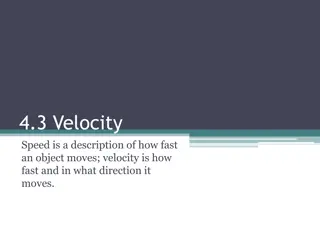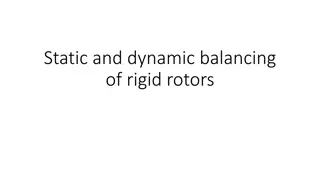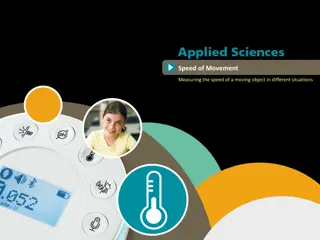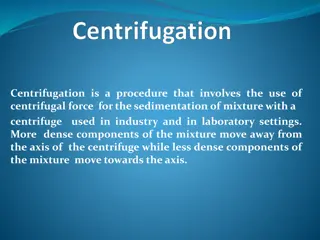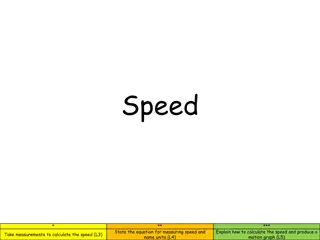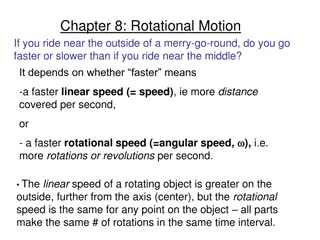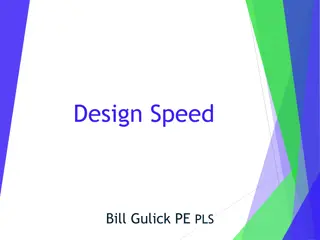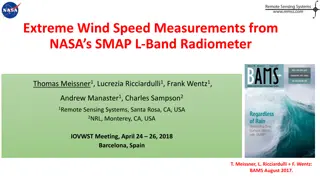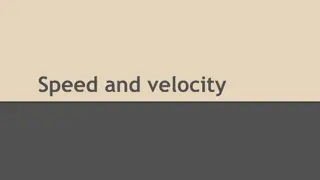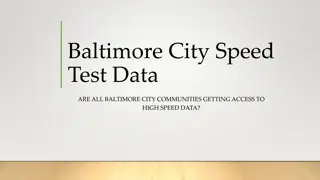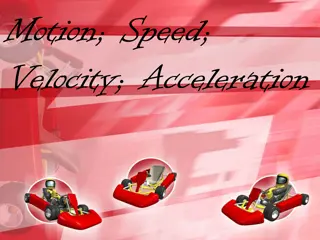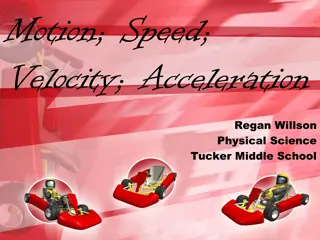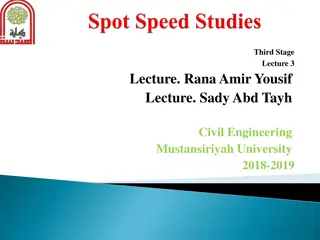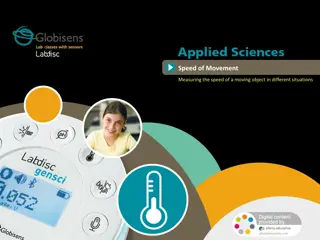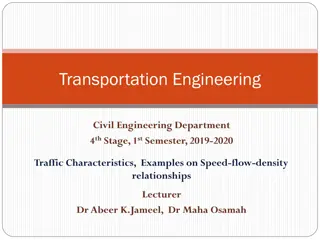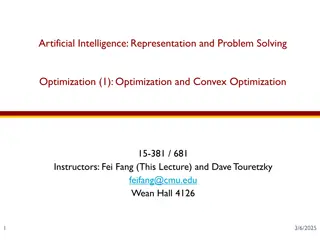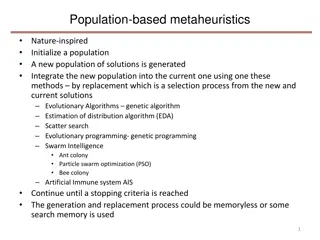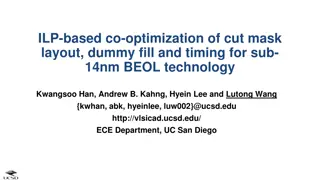Swarm Intelligence: Concepts and Applications
Swarm Intelligence (SI) is an artificial intelligence technique inspired by collective behavior in nature, where decentralized agents interact to achieve goals. Swarms are loosely structured groups of interacting agents that exhibit collective behavior. Examples include ant colonies, flocking birds,
7 views • 88 slides
Velocity vs. Speed in Physics
Velocity and speed are fundamental concepts in physics that describe how fast an object is moving and in what direction. While speed is a scalar quantity representing the rate of motion, velocity is a vector quantity that includes both speed and direction. Constant velocity implies steady speed and
6 views • 8 slides
Rigid Rotor Balancing and Critical Speed
Explore the concepts of static and dynamic balancing of rigid rotors, determining when a rotor can be assumed rigid based on speed, examining Jeffcott rotor critical speed problems, and discussing the simplest model of rotor systems. Learn about rotor imbalance, free vibrations, natural frequency, a
4 views • 29 slides
DNN Inference Optimization Challenge Overview
The DNN Inference Optimization Challenge, organized by Liya Yuan from ZTE, focuses on optimizing deep neural network (DNN) models for efficient inference on-device, at the edge, and in the cloud. The challenge addresses the need for high accuracy while minimizing data center consumption and inferenc
7 views • 13 slides
Speed of Movement in Different Situations
Exploring the concept of speed in the context of moving objects, this activity aims to analyze changes in speed, create hypotheses, and test them using a built-in GPS sensor. The theoretical background covers the definition of speed, its relation to distance and time, as well as the distinction betw
33 views • 27 slides
Discrete Optimization in Mathematical Modeling
Discrete Optimization is a field of applied mathematics that uses techniques from combinatorics, graph theory, linear programming, and algorithms to solve optimization problems over discrete structures. This involves creating mathematical models, defining objective functions, decision variables, and
4 views • 12 slides
Generalization of Empirical Risk Minimization in Stochastic Convex Optimization by Vitaly Feldman
This study delves into the generalization of Empirical Risk Minimization (ERM) in stochastic convex optimization, focusing on minimizing true objective functions while considering generalization errors. It explores the application of ERM in machine learning and statistics, particularly in supervised
6 views • 11 slides
Centrifugation: Industrial and Laboratory Applications
Centrifugation is a procedure that utilizes centrifugal force to separate components based on density in mixtures for both industrial and laboratory purposes. This process involves the rotation of particles at high speeds to induce sedimentation. Different types of centrifuges, such as low-speed and
6 views • 18 slides
Speed and Motion: Equations, Calculations, and Graphs
Speed is defined as the distance traveled per unit of time and is measured using the equation Speed = Distance/Time, with units typically in meters per second (m/s). To calculate speed, measure the distance traveled and the time taken. Motion graphs can be used to visualize speed by plotting time on
6 views • 11 slides
Insights into Recent Progress on Sampling Problems in Convex Optimization
Recent research highlights advancements in solving sampling problems in convex optimization, exemplified by works by Yin Tat Lee and Santosh Vempala. The complexity of convex problems, such as the Minimum Cost Flow Problem and Submodular Minimization, are being unraveled through innovative formulas
9 views • 47 slides
Approximation Algorithms for Stochastic Optimization: An Overview
This piece discusses approximation algorithms for stochastic optimization problems, focusing on modeling uncertainty in inputs, adapting to stochastic predictions, and exploring different optimization themes. It covers topics such as weakening the adversary in online stochastic optimization, two-sta
3 views • 33 slides
Rotational Motion: Linear vs. Angular Speed
Exploring the concept of rotational motion, this content delves into the comparison between linear speed (tangential speed) and rotational speed (angular speed). It discusses how the linear speed varies based on distance from the axis of rotation, while the rotational speed remains constant for all
6 views • 27 slides
Design Speed in Highway Engineering
Design speed in highway engineering refers to the selected speed used to determine the geometric features of roadways. It has evolved over time, with the current definition emphasizing safety, driver expectations, and balancing various factors like social, environmental, and economic considerations.
20 views • 12 slides
Extreme Wind Speed Measurements from NASA's SMAP L-Band Radiometer
NASA's SMAP (Soil Moisture Active Passive) mission has been collecting data on extreme wind speeds since April 2015 using an L-band radiometer. The measurements provide valuable insights into wind speed frequencies, with a wide range of signals received by the sensor challenging the data analysis. A
6 views • 17 slides
Speed and Velocity in Physics
Speed and velocity are fundamental concepts in physics. Speed is a scalar quantity that can be average or instantaneous, while velocity is a vector quantity that includes direction. Equations such as v=d/t help calculate these values. Average speed and average velocity are important in determining t
10 views • 10 slides
Flower Pollination Algorithm: Nature-Inspired Optimization
Real-world design problems often require multi-objective optimization, and the Flower Pollination Algorithm (FPA) developed by Xin-She Yang in 2012 mimics the pollination process of flowering plants to efficiently solve such optimization tasks. FPA has shown promising results in extending to multi-o
2 views • 15 slides
Baltimore City High-Speed Data Access Analysis
The Baltimore City Speed Test Data analysis examines the internet speed access in various communities within Baltimore City. The report includes details on average download speeds, communities with the lowest speeds, and a comparison of internet speed requirements for different online activities. Th
2 views • 7 slides
Motion, Speed, Velocity, and Acceleration
Motion is when an object changes its place or position. To describe motion accurately, consider the start and end position, movement relative to a reference point, distance traveled, and direction. Speed refers to the distance traveled per unit of time and can be calculated using the formula speed (
7 views • 25 slides
Motion, Speed, Velocity, and Acceleration in Physical Science
Explore the concepts of motion, speed, and velocity along with practical examples and calculations. Learn to describe motion, calculate speed using formulas, solve speed math problems, and understand the different ways to calculate speed. Dive into the world of physical science with explanations and
0 views • 26 slides
Machine Learning Applications for EBIS Beam Intensity and RHIC Luminosity Maximization
This presentation discusses the application of machine learning for optimizing EBIS beam intensity and RHIC luminosity. It covers topics such as motivation, EBIS beam intensity optimization, luminosity optimization, and outlines the plan and summary of the project. Collaborators from MSU, LBNL, and
5 views • 23 slides
Spot Speed Studies in Traffic Engineering
Spot speed studies are essential in estimating vehicle speeds in traffic streams, aiding in establishing traffic parameters, control measures, and safety evaluations. These studies involve recording vehicle speeds at specific locations to analyze speed trends, set speed limits, and assess the impact
2 views • 17 slides
Speed and Distance Estimation in Speed Trap Lab
Dive into the world of speed and distance estimation with the Speed Trap Lab. Learn how to calculate speed and distance, taking into consideration uncertainties and variations in time measurements. Explore the relationship between distance, time, and speed through engaging visual aids and practical
10 views • 4 slides
Fast Bayesian Optimization for Machine Learning Hyperparameters on Large Datasets
Fast Bayesian Optimization optimizes hyperparameters for machine learning on large datasets efficiently. It involves black-box optimization using Gaussian Processes and acquisition functions. Regular Bayesian Optimization faces challenges with large datasets, but FABOLAS introduces an innovative app
5 views • 12 slides
Measuring Movement Speed in Various Situations
Measuring the speed of movement is crucial for various applications. This article explores different methods and factors influencing speed measurement in diverse scenarios, highlighting the importance of accurate speed assessment in scientific research, sports, transportation, and more. Understandin
10 views • 27 slides
Transportation Engineering
In this detailed analysis, we explore traffic characteristics in transportation engineering, focusing on speed-density relationships, flow calculations, and capacity estimations for roadway sections. The example scenarios provide insights into free-flow speed, jam density, speed-flow relationships,
5 views • 19 slides
Machine learning optimization
Dive into the world of machine learning optimization with a focus on gradient descent, mathematical programming, and constrained optimization. Explore how to minimize functions using gradient descent and Lagrange multipliers, as well as the motivation behind direct optimization methods. Discover the
3 views • 16 slides
Artificial Intelligence: Representation and Problem Solving Optimization
This lecture explores optimization and convex optimization in the field of Artificial Intelligence, covering topics such as defining optimization problems, discrete and continuous variables, feasibility, and different types of optimization objectives. The content delves into the challenges and solut
1 views • 36 slides
Solving Problems on Speed, Distance, and Time
Learn how to calculate average speed, total distance, and total time taken in math problems involving speed, distance, and time. Understand the units of speed for different distances and time measurements. Practice solving scenarios to determine speed limits, travel distances, and average speeds of
25 views • 12 slides
Optimization Techniques for System Design
Introduction to optimization in system design, focusing on maximizing or minimizing objective functions. Explore types of optimization - unconstrained and constrained, with practical examples. Learn about computational methods for solving optimization problems and discover the implementation of opti
0 views • 12 slides
Practical Challenges in Portfolio Optimization
This paper delves into the practical challenges and current trends in portfolio optimization, discussing aspects related to using portfolio optimization in practice and highlighting new methods and developments. The content covers a brief introduction, Mean-Variance Optimization (MVO), extensions of
20 views • 18 slides
Motion and Speed in Physics
This content covers fundamental topics related to motion and speed in physics, focusing on concepts like frames of reference, distance, displacement, speed, velocity, and calculating speed. It explains how a frame of reference is used to describe motion, the distinction between speed and velocity, a
2 views • 27 slides
Nature-Inspired Population-Based Metaheuristics and Optimization Techniques
This comprehensive guide delves into various population-based metaheuristics and nature-inspired optimization techniques such as evolutionary algorithms, swarm intelligence, and artificial immune systems. It covers concepts like genetic algorithms, ant colony optimization, particle swarm optimizatio
5 views • 6 slides
Discrete Optimization in Graph Theory
Explore the relationship between counting techniques, graph theory, and discrete optimization, with examples illustrating the transition from counting problems to optimization problems. Learn about applying optimization in scheduling and making graph models, as well as the role of graphs in discrete
3 views • 8 slides
Cut Mask Co-Optimization for Advanced BEOL Technology
Explore the ILP-based co-optimization of cut mask layout, dummy fill, and timing for sub-14nm BEOL technology. The proposed approach addresses self-aligned multiple patterning, cut process extension, and the impact of cut mask optimization on wire performance. Learn about related works, motivation,
12 views • 23 slides
Transition to Very High-Speed Internet: Rieux-Latrape Journey
Delve into the transformation from High-Speed to Very High-Speed Internet in Rieux-Latrape on February 17, 2016. Uncover the history, past initiatives, and grasp the concept of High-Speed Internet. Learn about the evolution towards Very High-Speed Internet and the significance of this shift.
0 views • 17 slides
Understanding Motion, Speed, Velocity, and Acceleration in Physical Science
Explore the concepts of motion, speed, velocity, and acceleration in physical science, including definitions, formulas, calculations, and real-world examples. Learn how to describe motion, calculate speed, solve speed math problems, and understand different ways to calculate speed such as constant s
4 views • 26 slides
Problem Solving and Optimization in Artificial Intelligence
Explore the concepts of optimization and convex optimization in artificial intelligence, covering a variety of topics such as search, satisfiability, combinatorial and continuous optimization, and more. Delve into the definition of optimization problems, feasible regions, optimization objectives, an
1 views • 36 slides
Understanding Speed and Distance Measurement
Learn about measuring speed, calculating average speed, using speed cameras, and determining distance traveled with examples. Discover methods like light gates for measuring speed in a laboratory setting.
2 views • 12 slides
Understanding Linear Kinematics: Speed Concepts
Explore the fundamental concepts of speed in linear kinematics, including the definition of speed, average speed calculations, and practical examples. Utilize the provided formulas and examples to grasp the relationship between distance, time, and speed in various scenarios.
0 views • 17 slides
Rearranging Speed Equation and Examples
Learn how to mathematically rearrange the speed equation and calculate speed using the formula. Understand the concept of speed as the rate at which an object moves, and solve for distance and time in speed-related equations. Explore calculation examples to apply the speed formula in real-world scen
3 views • 11 slides

